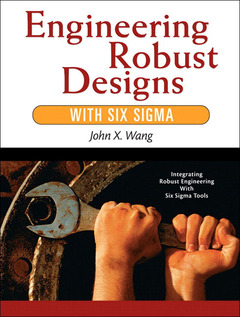Engineering robust design with six sigma
Langue : Anglais
Auteur : WANG John

This book is written for engineers who continue to have a dramatic impact on our world. The essence of the engineer's job is the engineering of robust products for the benefit of all people. A robust product is not just strong, it is also efficient, flexible, mistake-proof, and affordable. The term engineering robust products encompasses design and process flexibility, which rapidly and affordably accommodate changing customer requirements. As an engineer and an engineering manager, I have worked for the power utility, aerospace, transportation, automotive, and appliance industries. Engineers need to consider many factors when developing new products. For example, in developing a hybrid car, engineers determine precisely what function it needs to perform, design and test the components, fit the components together in an integrated plan, and evaluate the design's overall effectiveness, cost, reliability, serviceability, and safety. This process applies to many different products such as magnetic resonance imaging equipment, the Internet, gas turbines, helicopters, and even toy gyrocopters. Within the next decade, emerging technologies will make possible novel applications that integrate computation into design, manufacturing, and application environments: smart materials, self-reconfiguring robots, self-assembling nanostructures. Companies often face the challenge of achieving coherent and robust behavior from the interactions of a multitude of components and their interaction with design, manufacturing, and application. The new environments highlight the limits of current engineering practices and techniques, which are still highly dependent on precision parts and controlled processes to make products dependable and reliable.
Preface xiii About the Author xviiChapter 1. Achieving Robust Designs with Six Sigma: Dependable, Reliable, and Affordable 11.1 Six Sigma and Robust Design 1 1.2 Identify Project and Organize Team 3 1.3 Develop VOC Models 4 1.4 Formulate Critical-to-Quality Characteristics 6 1.5 Control Energy Transformation for Each CTQ Characteristic 8 1.6 Determine Control and Noise Factors 12 1.7 Assign Control Factors to the Inner Array 15 1.8 Summary and Road Map 20 Bibliography 23 Chapter 2. The Kano Model: Listening to the Voice-of-Customers 252.1 How to Make the Customer Happy 26 2.2 Customer Requirements Over Time 32 2.3 Control Factor Levels: Ensure Three Types of Quality 34 2.4 Noise-by-Control Analysis: Making Products More Robust 38 2.5 Variability Reduction 40 2.6 The Outer Array: An Orthogonal Array Specifying Multiple Noises 43 2.7 Selecting Noise Levels 45 2.8 Summary 47 Bibliography 48 Chapter 3. Quality Function Deployment: Building a House of Quality 513.1 Market Research and Determining Customers' Needs 52 3.2 Goal Tree: Spelling Out Unspoken Needs 55 3.3 Building a House of Quality 58 3.4 Deploy Quality Through Design of Experiments 63 3.5 Experiments for Deploying Robust Quality Functions 68 3.6 Summary 73 Bibliography 74Chapter 4. Theory of Inventive Problem Solving: Creating Robust Design Concepts 774.1 Contradiction: The Gateway to New Designs 79 4.2 Thirty-Nine Engineering Parameters to Standardize CTQs 80 4.3 Forty Principles to Identify Design Solutions 84 4.4 Calculating the Average of Control Factor Effects 93 4.5 Calculating the Effects of Noise Factors 96 4.6 Noise-by-Control Interaction Effects 99 4.7 Summary 102 Appendix 103 Bibliography 111Chapter 5. Failure Mode and Effect Analysis: Being Robust to Risk 1135.1 The Historical Context of FMEA 114 5.2 Using FMEA to Prevent Failure Before Any Harm Is Done 117 5.3 Identifying Functions and Failure Modes 118 5.4 Identifying Effects and Severity 123 5.5 Understanding Causes 127 5.6 Assessing Current Controls 129 5.7 Using FMEA for Risk Management 131 5.8 Summary 134 Bibliography 135Chapter 6. The P-Diagram: Laying Out a Robust Design Strategy 1396.1 Experimental Design and the P-Diagram 139 6.2 Quality Loss Function 147 6.3 Noise Factor Management Strategies 150 6.4 Three Phases: From Thought to Things 156 6.5 Summary 159 Bibliography 160Chapter 7. Parameter Design: Optimizing Control Factor Levels 1637.1 Identify Project and Team 166 7.2 Formulate Ideal Function 168 7.3 Formulate Dynamic Parameter Design 171 7.4 Assign Control Factors to an Inner Array 174 7.5 Assign Noise Factors and Signal to an Outer Array 178 7.6 Conduct the Experiment and Collect Data 183 7.7 Analyze the Data and Select an Optimal Design 186 7.8 Summary 192 Bibliography 193Chapter 8. Tolerance Design: Minimizing Life-Cycle Cost 1958.1 Tolerance Design versus Tolerancing 197 8.2 Reduction in Variability 201 8.3 Tightening Tolerance Selectively to Maximize Quality-versus-Cost Tradeoffs 203 8.4 Quantifying the Quality Loss Function 204 8.5 A Wheatstone Bridge System 210 8.6 Summary 213 Bibliography 216Chapter 9. Reliability Design: Giving Customers Long-Lasting Satisfaction 2199.1 Reliability and Six Sigma 220 9.2 Reliability and Stress-Strength Interference 231 9.3 Stress-Strength Interference Sigma Calculations 241 9.4 Summary 248 Bibliography 248Appendix. The Process Map: Engineering Robust Products with Six Sigma 251Index 255
Date de parution : 03-2005
Ouvrage de 264 p.
18x24 cm
Thèmes d’Engineering robust design with six sigma :
© 2024 LAVOISIER S.A.S.



